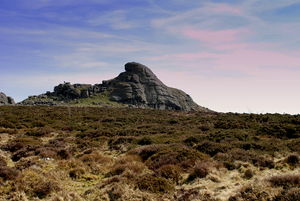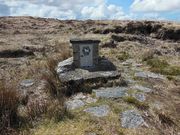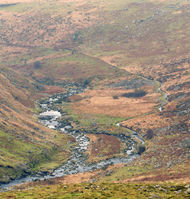Dartmoor
Dartmoor is an area of moorland in the county of Devon in south-west England, characterised by gentle slopes, granite tors and high rainfall creating much boggy ground and plentiful rivers. It is designated as a National Park. The highest points are High Willhays (621m or 2039 ft) and Yes Tor (619m or 2030 ft) near to each other on the north-west edge.[1]
The area covered by the National Park is 954 sq km (368 sq miles). Within this are several villages or small towns, the total population being estimated at around 34,000. The National Park Authority itself is responsible for planning, conservation, promotion of public access and some other functions. Other local authority services are provided by Devon County Council or the three district authorities which cover the area. The ownership of the land is varied. The Ministry of Defence carries out military training on 12,906 hectares (31,891 acres), of which 10,871 hectares (26,862 acres), known as the Defence Training Estate, is owned or leased by it. Just under half of the National Park is estimated to be moorland, the remainder being mostly farmland.[2]
Dartmoor is known for its ponies which roam freely on the moor. The ponies are semi-wild, but all have owners. Archaeological findings have shown that there were domesticated ponies about 3,500 years ago, and the earliest written record (a reference to wild horses owned by the Bishop of Crediton) dates from 1012. The numbers have reduced in recent years to about 3,000.[3]
Geology
The underlying rock of Dartmoor is a granite massif which has risen through the older sedimentary rocks around it. The mineral veins formed during this process include tin, copper, lead and iron. Granite can decompose into china clay, and this is extracted on the south-western slopes. In the same area a former wolfram (tungsten) mine is at the moment (2015) being reopened.
Scenery
Dartmoor is roughly bisected by the Swincombe River flowing into the Dart on the east side, and the river Meavy and its tributaries on the west. The watershed between these two rivers is just south of Princetown. North of this line the landscape is dominated by the tors, some of which, notably Great Mis Tor, Fur Tor and Sittaford Tor, are visible from large areas of the moor. Although there are tors south of the line, the far-seen landmarks tend to be of human origin, for instance, Three Barrows, the Eastern and Western White Barrows, and the enormous spoil tip at the disused Red Lake china clay works.
Cranmere Pool and Ducks Pool
The practice of "letterboxing" has developed over the years. A "letterbox" typically contains a rubber stamp for visitors to use on envelopes or other stationery, and a visitors' book. There are only two open and fairly permanent letterboxes on Dartmoor, at Cranmere Pool and Ducks Pool. All the others are concealed in some way and of a temporary nature. The one at Cranmere Pool is the origin of the activity. It was set up in 1854 by James Perrott, in the form of a small cairn containing a bottle in which gentlemen and ladies could place their visiting cards. Cranmere Pool is a remote location (not a pool these days) in the northern moor, by the source of the West Ockment river and near the sources of the Dart. The one at Ducks Pool was set up in 1938 in memory of William Crossing. The site was presumably chosen as being near the centre of the southern moor, as Cranmere Pool is near the centre of the northern moor. It is close to one of the tributaries of the Erme and although very wet, it is not really a pool. Both areas are bleak.
Rivers and leats
Most of the Dartmoor rivers run south into the English Channel. The only ones to run north to the Bristol Channel are the Taw and the Okement, which is a tributary of the Torridge. On the west side the Tavy with its tributary the Walkham run into the tidal stretches of the Tamar, which flows into Plymouth Sound. The Sound is also the outflow for the Plym and its tributary the Meavy. Rivers running directly into the English Channel from the southern moor are the Yealm, the Erme and the Aune or Avon. The East and West Dart originate in the northern moor, come together at Dartmeet, and enter the sea at Dartmouth. The Teign also starts in the northern moor and heads east before eventually flowing south to Teignmouth.
There are several reservoirs, notably Meldon on the West Okement, Fernworthy on the South Teign, Burrator on the Meavy, and the Avon Dam.
Leats are artificial water channels. Most start and end on Dartmoor, having been created to provide water and/or power for mining operations, mills and other users such as Dartmoor prison. They often follow very complicated courses and may take water from more than one source. In addition, two long-distance ones were constructed to bring water to towns. Plymouth leat, often known as Drake's leat, because its construction was supervised by Sir Francis Drake (who made a tidy profit by it), brought a water supply to Plymouth. Legend has it that when it was opened, Drake rode down the leat on a white horse, with the water following him. Since water was let into a new leat gradually and by stages, this is not improbable. It took water from the south-west moor and no longer exists as a continuous waterway. The Devonport leat later performed the same function for the expanding naval base at Devonport, and also took water from the south-west moor.
Dilapidation of leats varies greatly, but some are still in use.
Archaeology
The moor has been intensively used since at least the Bronze Age, without being intensively settled. This has resulted in the survival of many sites of archaeological interest, but the acid soil has destroyed much of the evidence in sites of human habitation and interment.
Neolithic
There is some evidence of neolithic settlement.
Bronze Age
There are many significant remains of settlements, burial sites and stone rows.
Because of the acid soil the recent (2011) discovery of a Bronze Age burial kist on Whitehorse Hill is not only rare in revealing organic material from that era, but unique to Dartmoor. The burial was of the remains from a human cremation, probably of a high status young woman. It has been dated to the Early Bronze Age, between 1900 and 1700 BC, and it has yielded much information about conditions at that time. The terrain seems to have shifted from being predominantly damp, to consisting, below the tops, of drier areas with moor grass and heathers, and, lower down, thin woodland. There is evidence of grazing. The kist contained fine quality woven goods, tin and copper alloy products, and turned wooden studs, unique at this period. The well-worn amber bead suggests trade with the Baltic that was already long-standing.[4]
A particular feature of Dartmoor is the survival of the reaves, low, broad stone walls which may have had hedges on top. Some of these extend for miles, others enclose considerable areas, while the smallest enclose what were obviously fields. In their present form they are thought to date from around 1700 to 1600 BCE, though they may overlie older trackways or forms of boundary. Some of them respect older structures, such as stone rows, while others violate them. It has been conjectured that the major ones demonstrate a sophisticated system of land division. They were first identified on Dartmoor, but since then others have been identified in other parts of the country.[5]
Medieval and later
Themoor shows conspicuous evidence of farming, warrening, tinning, mining for tin and other metals, peat extraction, quarrying, water extraction, and other activities. There are some deserted medieval villages.[6]
The moor in literature
The Sherlock Holmes story, The Hound of the Baskervilles was set on Dartmoor. Conan Doyle, who had been a GP in nearby Plymouth, stayed at a hotel in Princetown at the centre of the Moor, and was said to have had Foxtor Mire in mind when writing of the Great Grimpen Mire.
Dartmoor Prison
Dartmoor Prison started as part of Sir Thomas Tyrwhitt's project to develop Dartmoor. He committed himself to developing Princetown as a centre for the moor, it being adjacent to his new house at Tor Royal, and named in honour of the Prince Regent, a friend of his. In 1805 he persuaded the government of the desirability of using Princetown for building barracks for French prisoners of war, many of whom had been confined in hulks on the nearby river Tamar. Building started in 1806, to a radial design based on continental models and later advocated by Jeremy Bentham as the Panopticon,[7] except that the spokes of the wheel were supervised from the perimeter wall rather than from the central point.[8] In 1809 the first prisoners of war arrived, and the "depot", as it was first called, soon held 5,000 of them. None of them were actually engaged in building the prison, but some were employed in building the nearby church of St Michael and All Angels. During the war of 1812 American prisoners of war were also held there. Following the restoration of peace, the prison closed in 1816 and stood mainly empty until 1850, when it became a prison for those serving long-term sentences. The first of these did work on adapting the buildings to single cells. During the 1914-18 war it also housed conscientious objectors.
- ↑ [1]
- ↑ [2]
- ↑ [3]
- ↑ Dartmoor National Park Authority. Whitehorse Hill information booklet 2014 (associated with exhibition in Plymouth City Museum, 2014)
- ↑ Fleming, A. The Dartmoor Reaves: Investigating prehistoric land division. Batsford. 1988
- ↑ Newman, P. The Field Archaeology of Dartmoor. English Heritage. 2011
- ↑ Foucault, M. Surveiller et punir: Naissance de la prison. English translation by Alan Sheridan. Allen Lane. 1977
- ↑ Cherry, C and Pevsner, N. The Buildings of England: Devon. Yale University Press. 2004



